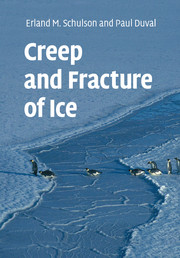Book contents
- Frontmatter
- Contents
- Preface
- Acknowledgements
- 1 Introduction
- 2 Structure of ice
- 3 Microstructure of natural ice features
- 4 Physical properties: elasticity, friction and diffusivity
- 5 Plastic deformation of the ice single crystal
- 6 Ductile behavior of polycrystalline ice: experimental data and physical processes
- 7 Modeling the ductile behavior of isotropic and anisotropic polycrystalline ice
- 8 Rheology of high-pressure and planetary ices
- 9 Fracture toughness of ice
- 10 Brittle failure of ice under tension
- 11 Brittle compressive failure of unconfined ice
- 12 Brittle compressive failure of confined ice
- 13 Ductile-to-brittle transition under compression
- 14 Indentation fracture and ice forces on structures
- 15 Fracture of the ice cover on the Arctic Ocean
- Index
- References
2 - Structure of ice
Published online by Cambridge University Press: 01 February 2010
- Frontmatter
- Contents
- Preface
- Acknowledgements
- 1 Introduction
- 2 Structure of ice
- 3 Microstructure of natural ice features
- 4 Physical properties: elasticity, friction and diffusivity
- 5 Plastic deformation of the ice single crystal
- 6 Ductile behavior of polycrystalline ice: experimental data and physical processes
- 7 Modeling the ductile behavior of isotropic and anisotropic polycrystalline ice
- 8 Rheology of high-pressure and planetary ices
- 9 Fracture toughness of ice
- 10 Brittle failure of ice under tension
- 11 Brittle compressive failure of unconfined ice
- 12 Brittle compressive failure of confined ice
- 13 Ductile-to-brittle transition under compression
- 14 Indentation fracture and ice forces on structures
- 15 Fracture of the ice cover on the Arctic Ocean
- Index
- References
Summary
Introduction
There are 12 crystalline forms of ice. At ordinary pressures the stable phase is termed ice I, terminology that followed Tammann's (1900) discovery of high-pressure phases. There are two closely related low-pressure variants: hexagonal ice, denoted Ih, and cubic ice, Ic. Ice Ih is termed ordinary ice whose hexagonal crystal symmetry is reflected in the shape of snow-flakes. Ice Ic is made by depositing water vapor at temperatures lower than about −130 ℃. High-pressure ices are of little interest in relation to geophysical processes on Earth, but constitute the primary materials from which many extra-terrestrial bodies are made. We describe their structure and creep properties in Chapter 8.
In addition to the 12 crystalline forms, there are two amorphous forms. One is termed low-density ice (940 kg m−3 at −196 ℃ at 1 atmosphere) and the other, high-density ice (1170 kg m−3, same conditions). The density of ice Ih is 933 kg m−3 at the same temperature and pressure (Hobbs, 1974). Amorphous ices can be made at low temperatures in five ways (see review by Mishima and Stanley, 1998): by condensing vapor below −160 ℃; by quenching liquid; by compressing ice Ih at −196 ℃; by electron irradiation; and through transformation upon warming from one amorphous state to another. Although once thought to be a nanocrystalline material, amorphous ice is now considered to be truly glassy water. Its mechanical behavior remains to be explored.
In this chapter we address the structure of ice Ih.
- Type
- Chapter
- Information
- Creep and Fracture of Ice , pp. 5 - 29Publisher: Cambridge University PressPrint publication year: 2009
References
- 1
- Cited by



